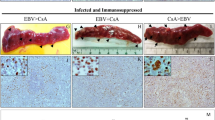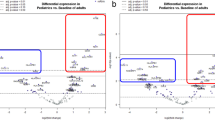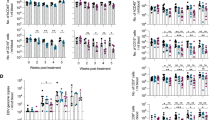Abstract
Epstein–Barr virus (EBV) is involved in the pathogenesis of several B cell lymphoproliferations, but the precise contribution it makes to the aetiology of each remains unclear. In vitro, the virus has potent growth transforming activity and efficiently induces the continuous proliferation of normal human B cells. A comparison of EBV-infected primary B cells with an isogenic population induced to proliferate by CD40-ligand (CD40L) and IL4 has revealed that EBV can override – by a novel mechanism – the p53/pRb-mediated G1 checkpoint activated in normal B cells by a genotoxic stress. In cells responding to cisplatin, although p53 is stabilized and activated, EBV latent gene expression appears to inhibit the accumulation of newly synthesized p21WAF1/CIP1 and the downregulation of cyclin D2 that occur in the normal cells. Consequently, in the EBV-infected cells, CDK2 remains active, hyperphosphorylation of pRb is maintained and the replication of damaged DNA can occur. Under conditions of severe genomic stress, this absence of p21WAF1/CIP1 function can result in apoptosis; however, when damage is less sustained, genomic instability may arise and this in turn could contribute to the development of a variety of EBV-associated B cell malignancies.
This is a preview of subscription content, access via your institution
Access options
Subscribe to this journal
Receive 50 print issues and online access
$259.00 per year
only $5.18 per issue
Buy this article
- Purchase on SpringerLink
- Instant access to full article PDF
Prices may be subject to local taxes which are calculated during checkout








Similar content being viewed by others
References
Agami R and Bernards R . (2002). Cancer Lett., 177, 111–118.
Allday MJ, Sinclair A, Parker G, Crawford DH and Farrell PJ . (1995a). EMBO J., 14, 1382–1391.
Allday MJ, Inman GJ, Crawford DH and Farrell PJ . (1995b). EMBO J., 14, 4994–5005.
Banchereau J, dePaoli P, Valle A, Garcia E and Rousset F . (1991). Science, 251, 70–72.
Bartek J and Lukas J . (2001). Curr. Opin. Biol., 13, 738–747.
Blagosklonny MV, Wu GS, Omura S and El-Deiry WS . (1996). Biochem. Biophys. Res. Commun., 227, 564–569.
Bornkamm GW and Hammerschmidt W . (2001). Philos. Trans. R. Soc. Lond. B, 356, 437–459.
Cannell EJ, Farrell PJ and Sinclair AJ . (1996). Oncogene, 13, 1413–1421.
Cannell EJ, Farrell PJ and Sinclair AJ . (1998). FEBS Lett., 439, 297–301.
Chattopadhyay D, Ghosh MK, Mal A and Harter ML . (2001). J. Virol., 75, 9844–9856.
Dotto GP . (2000). Biochim. Biophys. Acta, 1471, M43–M56.
Garrone P, Neidhardt EM, Garcia E, Galibert L, van Kooten C and Banchereau J . (1995). J. Exp. Med., 182, 1265–1273.
Hartwell LH and Kastan MB . (1994). Science, 266, 1821–1828.
Hoeijmakers JHJ . (2001). Nature, 411, 366–374.
Kelly G, Bell A and Rickinson AB . (2002). Nat. Med., 8, 1098–1104.
Knowles DM, Cesarman E, Chadburn A, Frizzera G, Chen J, Rose EA and Michler RE . (1995). Blood, 85, 552–565.
Kriwacki RW, Hengst L, Tennant L, Reed SI and Wright PE . (1996). Proc. Natl. Acad. Sci. USA, 93, 11504–11509.
Linndstrom MS and Wiman KG . (2002). Cancer Biol., 12, 381–387.
Lui C-W, Corboy MJ, DeMartino GN and Thomas PJ . (2003). Science, 299, 408–411.
Maki CG and Howley PM . (1997). Mol. Cell. Biol., 17, 355–363.
Palmero I, Holder A, Sinclair A, Dickson C and Peters G . (1993). Oncogene, 8, 1049–1054.
Parker GA, Touitou R and Allday MJ . (2000). Oncogene, 19, 700–709.
Paulovich AG, Toczyski DP and Hartwell LH . (1997). Cell, 88, 315–321.
Polyak K, Waldmann T, He TC, Kinzler KW and Vogelstein B . (1996). Genes Dev., 10, 1945–1952.
Rickinson AB . (2001). Philos. Trans. R. Soc. Lond. B, 356, 595–604.
Rousset F, Peyrol S, Garcia E, Vezzio N, Andujar M, Grimaud JA and Banchereau J . (1995). Int. Immunol., 7, 1243–1253.
Scott MT, Ingram A and Ball KL . (2002). EMBO J., 21, 6771–6780.
Sheaff RJ, Singer JD, Swanger J, Smitherman M, Roberts JM and Clurman B . (2000). Mol. Cell, 5, 403–410.
Sherr CJ and Roberts JM . (1999). Genes Dev., 13, 1501–1512.
Shvarts A, Brummelkamp TR, Scheeren F, Koh E, Daley GC, Spits H and Bernards R . (2002). Genes Dev., 16, 681–686.
Sinclair AJ, Palmero I, Peters G and Farrell PJ . (1994). EMBO J., 13, 3321–3328.
Speck S . (2002). Nat. Med., 8, 1086–1087.
Spender LC, Cannell EJ, Hollyoake M, Wensing B, Gawn JM, Brimmell M, Packham G and Farrell PJ . (1999). J. Virol., 73, 4678–4688.
Spender LC, Cornish GH, Rowland B, Kempkes B and Farrell PJ . (2001). J. Virol., 75, 3537–3546.
Spruck CH, Won K-A and Reed S . (1999). Nature, 401, 297–300.
Thorley-Lawson D . (2001). Nat. Rev. Immunol., 1, 75–82.
Thorley-Lawson D and Babcock GJ . (1999. Life Sci., 65, 1433–1453.
Timms JM, Bell A, Flavell JR, Murray PG, Rickinson AB, Traverse-Glehen A, Berger F and Delecluse HJ . (2003). Lancet, 361, 217–223.
Touitou R, Richardson J, Bose S, Nakanishi M, Rivett J and Allday MJ . (2001). EMBO J., 20, 2367–2375.
Wade M and Allday MJ . (2000). Mol. Cell. Biol., 20, 1344–1360.
Waldman T, Lengauer C, Kinzler KW and Vogelstein B . (1996). Nature, 381, 713–716.
Zhang Y, Fujita N and Tsuruo T . (1999). Oncogene, 18, 1131–1138.
Acknowledgements
We are grateful to Paul Farrell, Roger Watson and Mark Wade for helpful comments on the manuscript and to Xin Lu and Martin Rowe for antibodies. We also like to thank the Wellcome Trust for financial support through programme Grant No. 056822 to MJA and a Wellcome Trust Prize Studentship to JO.
Author information
Authors and Affiliations
Corresponding author
Rights and permissions
About this article
Cite this article
O'Nions, J., Allday, M. Epstein–Barr virus can inhibit genotoxin-induced G1 arrest downstream of p53 by preventing the inactivation of CDK2. Oncogene 22, 7181–7191 (2003). https://doi.org/10.1038/sj.onc.1206838
Received:
Revised:
Accepted:
Published:
Issue date:
DOI: https://doi.org/10.1038/sj.onc.1206838
Keywords
This article is cited by
-
Treatment with a BH3 mimetic overcomes the resistance of latency III EBV (+) cells to p53-mediated apoptosis
Cell Death & Disease (2011)
-
EBV-positive Hodgkin lymphoma is associated with suppression of p21cip1/waf1 and a worse prognosis
Molecular Cancer (2010)
-
Activation of p53 by MDM2 antagonists has differential apoptotic effects on Epstein–Barr virus (EBV)-positive and EBV-negative Burkitt's lymphoma cells
Leukemia (2009)
-
Two Epstein–Barr virus (EBV) oncoproteins cooperate to repress expression of the proapoptotic tumour-suppressor Bim: clues to the pathogenesis of Burkitt's lymphoma
Oncogene (2008)
-
Epstein–Barr virus promotes genomic instability in Burkitt's lymphoma
Oncogene (2007)



